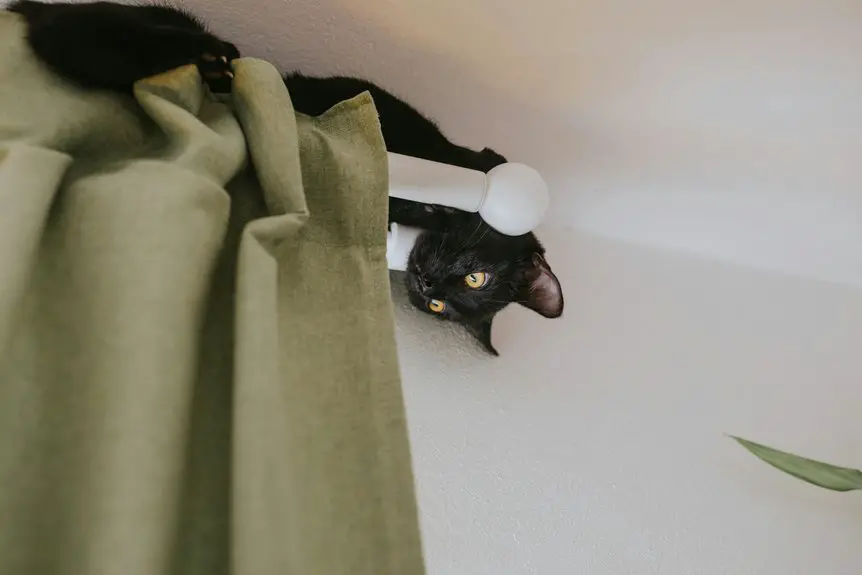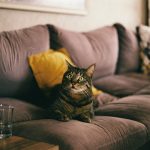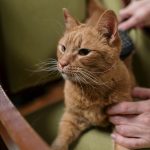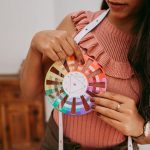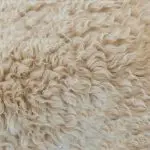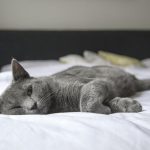You want upholstery that stands up to your cat’s claws, resists stains, and hides fur and scratches. Microfiber is a top choice thanks to its tightly woven, durable fibers that resist snagging and are easy to clean. Synthetic blends with nylon or polyester also hold up well, especially when paired with tight weaves and darker colors or patterns to mask wear. Keep your furniture fresh and sturdy with these tips, and you’ll discover even more smart fabric options ahead.
Table of Contents
Key Takeaways
- Choose tightly woven fabrics like microfiber or Crypton for superior resistance to cat claws and snagging.
- Opt for durable synthetic fibers such as nylon or polyester blends to enhance abrasion resistance and longevity.
- Select stain-resistant and moisture-repellent materials to simplify cleaning and prevent odor retention.
- Favor smooth, low-pile textures that minimize pet hair adherence and ease maintenance.
- Use medium to dark tones or patterned fabrics to effectively camouflage pet hair, scratches, and stains.
Understanding the Challenges of Pet-Friendly Upholstery
Although pet-friendly upholstery promises durability, it still faces unique challenges that you need to reflect on. Your pet’s claws can snag and tear fabric, while shedding fur clings to materials, making cleaning tougher.
Stains from accidents or dirt track in quickly, so you have to think about stain resistance. Odors can also settle into fabric fibers, requiring you to take into account breathability and easy maintenance.
Additionally, pets might chew or scratch, testing the fabric’s strength and resilience. You’ll want to balance softness for comfort with toughness to withstand wear and tear.
Understanding these challenges helps you make smarter choices, ensuring your upholstery stands up to your pet’s active lifestyle without sacrificing style or comfort.
Key Features of Durable Upholstery Fabrics for Pets
To tackle the challenges pets bring to your furniture, you need fabrics designed to handle wear and tear without compromising comfort.
Look for materials with tight weaves that resist claws and prevent snagging. Durability matters, so choose fabrics made from strong fibers like nylon or polyester blends, which stand up to scratching and daily use.
Choose tightly woven fabrics with strong fibers like nylon or polyester to resist claws and daily wear.
Stain resistance is essential since accidents happen; opt for fabrics treated to repel liquids and easy to clean. You’ll want something that doesn’t attract pet hair easily—smooth surfaces or fabrics with low pile work best.
Finally, consider color and pattern to hide fur and minor blemishes. Picking upholstery with these features guarantees your furniture stays looking fresh despite your furry friends’ antics.
Why Microfiber Is a Top Choice for Cat Owners
You want upholstery that can handle your cat’s claws without showing wear, and microfiber fits the bill with its durability and scratch resistance.
It’s also a breeze to clean, making it perfect for quick messes or shedding.
Choosing microfiber means less stress about damage and more time enjoying your furry friend.
Durable and Scratch-Resistant
Since cats love to scratch, choosing a durable and scratch-resistant fabric is essential for your upholstery.
Microfiber stands out because its tightly woven fibers resist claws better than many other materials. When your cat tries to sharpen its nails, microfiber doesn’t easily snag or tear, keeping your furniture looking fresh longer.
Plus, microfiber’s synthetic nature offers strength without sacrificing softness, so your couch stays comfy for both you and your pet. With its dense weave, microfiber also prevents your cat’s claws from causing deep damage.
This durability means you won’t have to replace or repair your upholstery as often, saving you time and money. If you want furniture that withstands your cat’s playful scratching, microfiber is a smart, practical choice.
Easy to Clean
Although pets can make any home feel lively, their fur and occasional messes can quickly turn upholstery into a challenge. That’s why microfiber stands out for cat owners. It’s tightly woven, making it resistant to dirt and easy to wipe clean. Spills won’t soak in, and pet hair barely sticks, so you can keep your furniture looking fresh with minimal effort.
| Feature | Benefit for Cat Owners |
|---|---|
| Tight Weave | Prevents dirt and fur penetration |
| Stain Resistance | Allows easy cleanup of spills |
| Soft Texture | Comfortable for pets and people |
| Durability | Holds up against claws and wear |
Choosing microfiber means you don’t have to stress about daily wear and tear from your feline friends.
Leather Upholstery: Pros and Cons for Pet Households
Leather upholstery offers several advantages and drawbacks for pet households that you should consider before making a choice.
On the plus side, leather is relatively easy to clean—you can wipe off pet hair and spills quickly without much hassle. It doesn’t trap odors or allergens like some fabrics, which is great if your pets spend a lot of time on the furniture.
However, leather can be vulnerable to scratches and punctures from cat claws or dog nails, which might leave visible marks. If your pets are particularly active or have sharp nails, you may find leather less durable over time.
Ultimately, if you’re willing to maintain it properly and your pets are gentle, leather can work well; otherwise, you might want to explore other options.
Synthetic Fabrics That Resist Pet Damage
When you want upholstery that stands up to claws and spills, synthetic fabrics offer a durable and pet-friendly solution.
Materials like microfiber, nylon, and polyester resist scratches and repel stains better than many natural fibers. You’ll find microfiber especially useful—it’s tightly woven, making it tough for pets’ claws to snag and easy for you to clean up fur or messes.
Nylon’s strength and elasticity help it bounce back from wear and tear, while polyester provides a smooth surface that pets can’t easily damage.
These fabrics also dry quickly and resist odors, keeping your furniture fresh.
Natural Fibers That Work Well With Pets
Since natural fibers can offer both comfort and durability, they make great choices for pet-friendly upholstery.
Cotton and linen are breathable and soft, so your pets will love lounging on them. However, they can attract pet hair and stains more easily, so choosing tightly woven options helps minimize damage.
Wool is naturally stain-resistant and durable, making it a solid pick for homes with active pets. Plus, its texture can discourage scratching.
Hemp and jute are strong and eco-friendly, but they might feel rough to some pets.
When selecting natural fibers, look for blends that combine durability with softness to keep both you and your pets happy.
Natural fabrics balance style and function, so you don’t have to sacrifice comfort or pet safety in your home.
Cleaning and Maintenance Tips for Pet-Friendly Fabrics
Although pet-friendly fabrics are designed to withstand wear and tear, you’ll need to clean and maintain them regularly to keep them looking their best. Start by vacuuming often to remove pet hair and dirt. Treat stains quickly with mild soap and water or a fabric cleaner recommended by the manufacturer. Avoid harsh chemicals that can damage fibers. Rotate cushions to guarantee even wear and prevent fading. If your fabric is machine washable, follow care instructions carefully to maintain texture and color.
| Cleaning Tip | Maintenance Action |
|---|---|
| Vacuum weekly | Rotate cushions monthly |
| Spot clean spills | Use pet covers when needed |
| Use mild cleaners | Avoid direct sunlight |
| Brush fabric gently | Trim pet nails regularly |
| Air out cushions | Inspect for damage often |
How Fabric Weave Impacts Pet Durability
When choosing upholstery, you’ll want to contemplate how the fabric weave affects durability against pets.
Tight weaves and durable fiber blends resist scratches and wear better than loose weaves.
Paying attention to texture can also make a big difference in how well your furniture holds up.
Tight vs. Loose Weaves
If you want your upholstery to withstand the wear and tear from pets, understanding the difference between tight and loose fabric weaves is essential. Tight weaves pack fibers closely, making the fabric more resistant to claws and less likely to snag. Loose weaves, however, have gaps that can catch claws and trap pet hair, reducing durability.
| Weave Type | Pet Durability Impact |
|---|---|
| Tight | Resists claw snags, repels hair |
| Loose | Prone to snagging, traps hair |
| Tight | Maintains shape, less pilling |
Choosing tight weaves helps your furniture stay intact longer, even with active pets. Loose weaves might look cozy but won’t hold up as well under pet stress.
Durable Fiber Blends
Because fabric weave plays an essential role in pet durability, choosing the right fiber blends can further enhance your upholstery’s resilience.
Blending natural fibers like cotton with synthetic ones such as polyester or nylon often results in a fabric that balances comfort with toughness. These combinations improve resistance to wear and tear caused by pets jumping, scratching, or clawing.
Polyester, for example, adds strength and helps maintain shape, while nylon offers high abrasion resistance. When you select upholstery with durable fiber blends, you’re less likely to see pilling or fraying from your furry friend’s activities.
Keep in mind that the fiber content works hand-in-hand with the weave; sturdy blends paired with tight weaves create upholstery that stands up better to daily pet use, making your furniture last longer without sacrificing style or comfort.
Texture and Scratch Resistance
Although fiber blends play an essential role, the fabric’s weave considerably affects how well your upholstery resists scratches and maintains its texture. Tight weaves create a denser surface that stands up better to your pet’s claws, while loose weaves tend to snag and wear quickly. You’ll want to choose fabrics that combine durability with a texture that hides minor scratches and prevents fuzzing.
| Weave Type | Scratch Resistance |
|---|---|
| Plain Weave | High – tightly packed, durable |
| Twill Weave | Moderate – diagonal pattern hides wear |
| Satin Weave | Low – smooth but prone to snagging |
| Basket Weave | Moderate – thicker yarns, decent resilience |
Picking the right weave helps your furniture look great longer despite your pet’s activity.
Color and Pattern Considerations for Pet Owners
How do you choose colors and patterns that keep your furniture looking fresh despite your pet’s presence? Start by matching upholstery shades to your pet’s fur color to minimize visible shedding.
Dark fabrics can hide stains better, while medium tones often balance wear and dirt effectively. Patterns like plaids, florals, or intricate weaves distract the eye and camouflage minor scratches or stains.
Avoid solid light colors—they tend to show pet hair and dirt quickly. Also, consider how your pet’s activity level might affect wear: busier patterns can mask damage over time.
Innovations in Pet-Resistant Upholstery Materials
Choosing the right colors and patterns helps hide pet hair and wear, but the fabric itself plays a huge role in durability and cleanliness.
Today, innovative pet-resistant materials are designed specifically to stand up to claws, spills, and shedding. Look for fabrics with tightly woven fibers, like microfiber or Crypton, which resist stains and repel moisture.
Some new textiles even incorporate antimicrobial treatments to prevent odors and bacteria buildup. You’ll also find fabrics engineered with reinforced weaves to minimize snags from cat claws.
Plus, eco-friendly options use recycled materials without sacrificing strength. By choosing these advanced fabrics, you make your furniture easier to clean and more resilient, ensuring it stays looking fresh and pet-ready for years to come.
Frequently Asked Questions
Are There Upholstery Fabrics That Help Reduce Pet Allergens?
Oh sure, because pets just love to magically stop shedding! But seriously, you can choose tightly woven fabrics like microfiber or leather that trap fewer allergens, making your home a bit less sneezy while still welcoming your furry friends.
How Do Pet Odors Affect Different Upholstery Materials?
Pet odors cling differently depending on upholstery material. Natural fibers like cotton absorb smells more, while synthetic fabrics resist and release odors easier. You’ll want easy-to-clean fabrics to keep your home smelling fresh despite pets.
Can Pet-Friendly Fabrics Be Used Outdoors Safely?
You can use pet-friendly fabrics outdoors, but make sure they’re specially treated for UV resistance and moisture. Otherwise, they might fade or mildew quickly. Always check care instructions to keep your outdoor space safe and comfy.
Do Pet-Friendly Upholstery Fabrics Affect Furniture Comfort?
You won’t usually notice a difference in comfort with pet-friendly upholstery fabrics. They’re designed to be durable yet soft, so your furniture stays cozy while resisting scratches and stains, keeping your space both comfy and practical.
Are There Eco-Friendly Pet-Resistant Upholstery Options?
You can find eco-friendly pet-resistant upholstery options made from organic cotton, hemp, or recycled fibers. These fabrics offer durability and stain resistance while minimizing environmental impact, letting you protect furniture and stay green simultaneously.
- Recycling Nonwoven Fabrics: Is It Possible? - July 11, 2025
- Recycling Nonwoven Fabrics: Is It Possible? - July 11, 2025
- Recycling Nonwoven Fabrics: Is It Possible? - July 11, 2025

